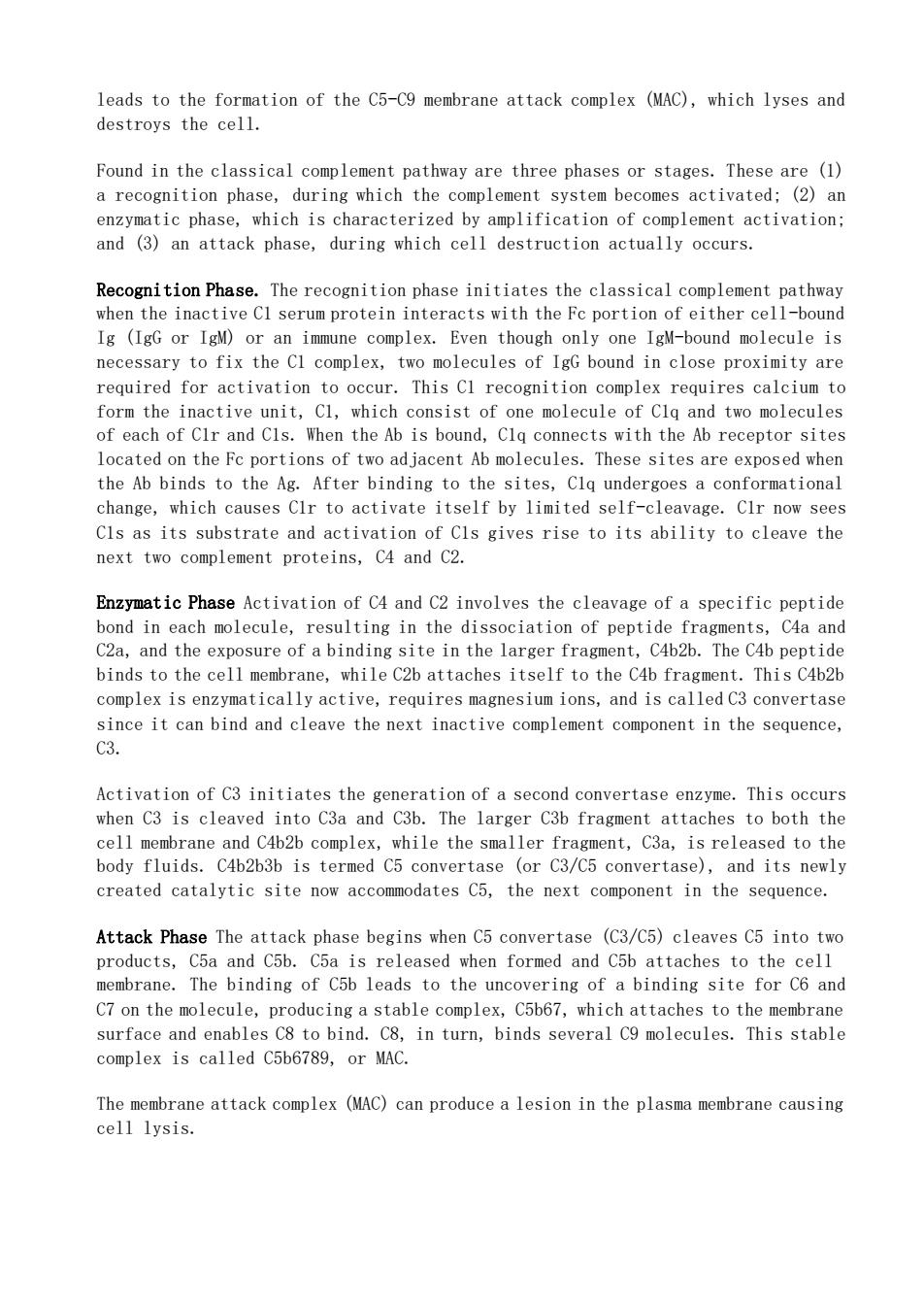正在加载图片...

leads to the formation of the C5-C9 membrane attack complex (MAC),which lyses and destroys the cell. Found in the classical complement pathway are three phases or stages.These are (1) a recognition phase. during which the complement system becomes activated:(2)an enzymtic phase,which is characterized by amplification of complement activation: and (3)an attack phase,during which cell destruction actually occurs. Recognition Phase.The recognition phase initiates the classical complement pathway when the inactive Cl serum protein interacts with the Fc portion of either cell-bound Ig (IgG or IgM)or an immune complex.Even though only one IgM-bound molecule is necessary to fix the Cl complex,two mole ecules of IgG bound in close proximity are required for activation to occur.This Cl recognition complex requires calcium to form the inactive unit,Cl,which consist of one molecule of Clq and two molecules of each of Clr and Cls.When the Ab is bound,Clq connects with the Ab receptor sites located on the Fc portions of two adjacent Ab molecules.These sites are exposed when the Ab binds to the Ag.After binding to the site Clq undergoes a conformational change,which causes Clr to activate itself by limited self-cleavage.CIr now sees Cls as its substrate and activation of Cls gives rise to its ability to cleave the next two complement proteins,C4 and C2. Enzymatic Phase Activation of C4 and C2 involves the cleavage of a specific peptide deee ren the disociation or ents, C4a and osure of a binding site in the larger fragment The C4b peptid binds to the cell membrane,while C2b attaches itself to the C4b fragment.This C4b2 complex is enzymatically active,requires magnesium ions,and is called C3 convertase since it can bind and cleave the next inactive complement component in the sequence, ctivation of c3 initiatess the ronerati n C3 is cleaved cell membrane and C4b2b complex,while the smaller fragment,C3a,is released to the body fluids.C4b2b3b is termed C5 convertase (or C3/C5 convertase),and its newly created catalytic site now accommodates C5.the next component in the sequence. Attack Phase The attack phase begins when C5 convertase (C3/C5)cleaves C5 into tw products, d c5b. s released when forme an.binding of Csh lends to the unoito roe ced C7 on the molecule,producing a stable complex,C5b67,which attaches to the membrane surface and enables C8 to bind.C8,in turn,binds several C9 molecules.This stable complex is called C5b6789,or MAC. The membrane attack complex (MAC)can produce a lesion in the plasma membrane causing cell lysis. leads to the formation of the C5-C9 membrane attack complex (MAC), which lyses and destroys the cell. Found in the classical complement pathway are three phases or stages. These are (1) a recognition phase, during which the complement system becomes activated; (2) an enzymatic phase, which is characterized by amplification of complement activation; and (3) an attack phase, during which cell destruction actually occurs. Recognition Phase. The recognition phase initiates the classical complement pathway when the inactive C1 serum protein interacts with the Fc portion of either cell-bound Ig (IgG or IgM) or an immune complex. Even though only one IgM-bound molecule is necessary to fix the C1 complex, two molecules of IgG bound in close proximity are required for activation to occur. This C1 recognition complex requires calcium to form the inactive unit, C1, which consist of one molecule of C1q and two molecules of each of C1r and C1s. When the Ab is bound, C1q connects with the Ab receptor sites located on the Fc portions of two adjacent Ab molecules. These sites are exposed when the Ab binds to the Ag. After binding to the sites, C1q undergoes a conformational change, which causes C1r to activate itself by limited self-cleavage. C1r now sees C1s as its substrate and activation of C1s gives rise to its ability to cleave the next two complement proteins, C4 and C2. Enzymatic Phase Activation of C4 and C2 involves the cleavage of a specific peptide bond in each molecule, resulting in the dissociation of peptide fragments, C4a and C2a, and the exposure of a binding site in the larger fragment, C4b2b. The C4b peptide binds to the cell membrane, while C2b attaches itself to the C4b fragment. This C4b2b complex is enzymatically active, requires magnesium ions, and is called C3 convertase since it can bind and cleave the next inactive complement component in the sequence, C3. Activation of C3 initiates the generation of a second convertase enzyme. This occurs when C3 is cleaved into C3a and C3b. The larger C3b fragment attaches to both the cell membrane and C4b2b complex, while the smaller fragment, C3a, is released to the body fluids. C4b2b3b is termed C5 convertase (or C3/C5 convertase), and its newly created catalytic site now accommodates C5, the next component in the sequence. Attack Phase The attack phase begins when C5 convertase (C3/C5) cleaves C5 into two products, C5a and C5b. C5a is released when formed and C5b attaches to the cell membrane. The binding of C5b leads to the uncovering of a binding site for C6 and C7 on the molecule, producing a stable complex, C5b67, which attaches to the membrane surface and enables C8 to bind. C8, in turn, binds several C9 molecules. This stable complex is called C5b6789, or MAC. The membrane attack complex (MAC) can produce a lesion in the plasma membrane causing cell lysis